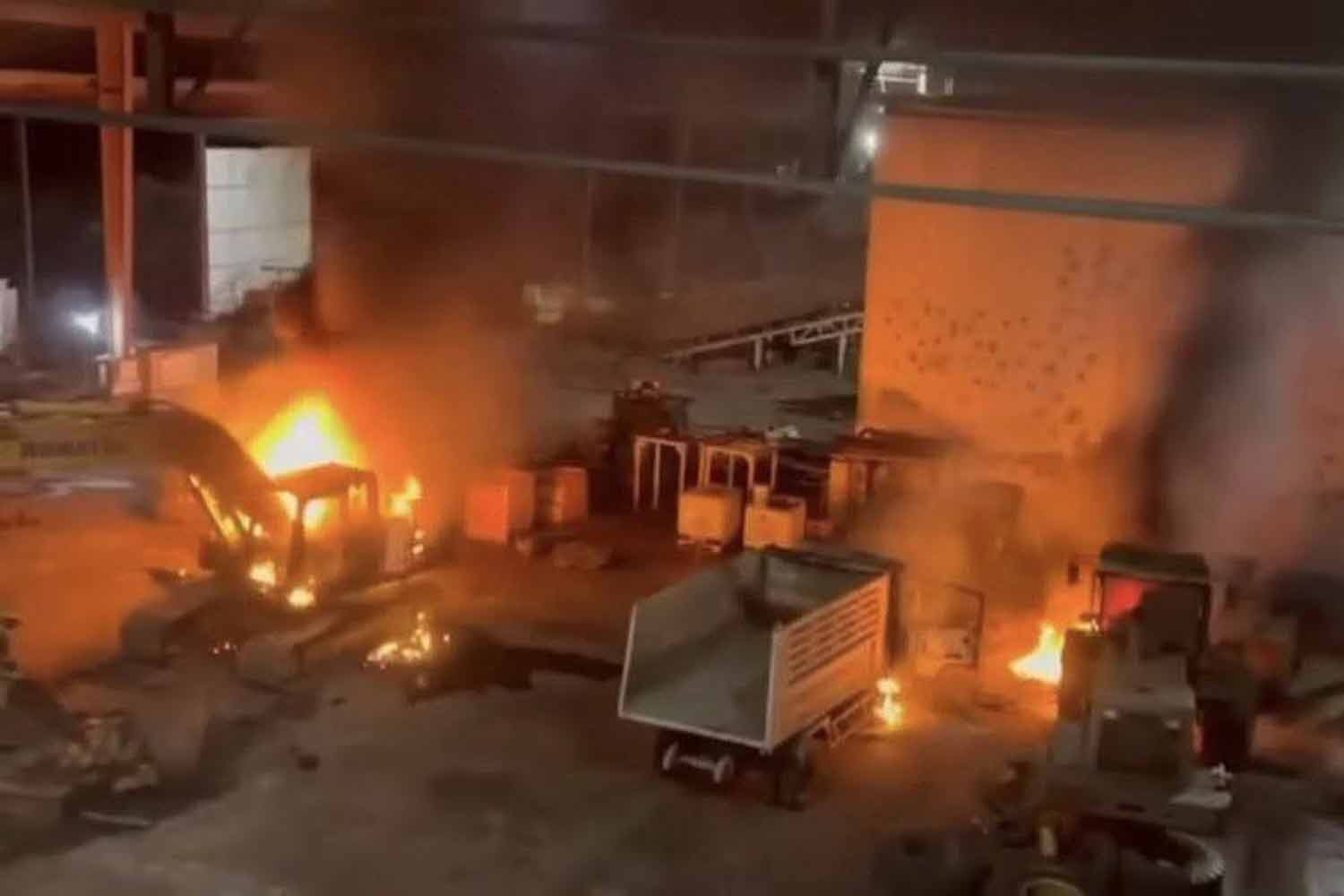The Fourth Army Region has tightened security across the deep south after insurgents attacked a biomass power plant in Narathiwat’s Waeng district, highlighting ongoing threats to critical infrastructure in the region. The attack, carried out by a group of armed assailants, resulted in damage to equipment and disruption of operations, prompting a swift security response from military authorities. No casualties were reported in the incident, but the event underscores persistent security challenges in Narathiwat and the broader deep south, where safeguarding energy facilities and transport networks remains a top priority for regional and national authorities.
Context and Background
The deep south of Thailand has long been a focal point for security concerns, with a history of insurgent activity, sporadic violence, and clashes involving local groups and government forces. Narathiwat, one of the southernmost provinces bordering Malaysia, has endured elevated risk levels for years, affecting daily life, economic activity, and the resilience of essential services. The strategic importance of Narathiwat is compounded by its proximity to cross-border routes and its role in regional energy and transport networks. In this environment, security agencies routinely conduct heightened patrols, intelligence-led operations, and targeted measures to protect critical infrastructure, including power plants, electrical grids, water facilities, and transportation corridors that link communities to markets and services.
The Fourth Army Region, a principal military command structure in the area, is tasked with maintaining stability, preventing insurgent activity from disrupting civilian life, and coordinating security actions across multiple southern provinces. Its mandate includes protecting critical infrastructure, which encompasses electricity generation facilities, water systems, and major transport routes that facilitate commerce and humanitarian support. The security framework in Narathiwat and neighboring provinces relies on a combination of military patrols, police collaboration, and partnerships with private sector operators who own or operate essential facilities. Within this framework, the focus is on risk assessment, rapid response to incidents, and ongoing surveillance to deter attacks and reduce vulnerability.
Within Narathiwat, the security landscape is shaped by frequent but intermittent threats that can range from small-scale assaults to more deliberate disruptions targeting utilities and logistics. The regional authorities emphasize preventive measures, including reinforced security at sites housing critical infrastructure, routine checks around industrial zones, and proactive patrolling in zones deemed high-risk due to historical patterns of violence or intelligence indicators. The aim is to create a deterrent effect while ensuring that essential services continue to function with minimal interruption. In this context, any attack on an energy facility not only threatens local electricity supply but also signals the ability of insurgent groups to reach sensitive infrastructure, prompting a recalibration of security protocols and deployment of additional resources.
The attack on the Price of Wood Green Energy Co Ltd biomass plant within tambon Kayu Klah in Waeng district is significant within Narathiwat’s broader energy infrastructure landscape. Biomass facilities, like other power generation sites, rely on a combination of physical security, access control, and robust on-site response capabilities to prevent sabotage, theft, or harm to personnel. When such facilities are attacked, the consequences extend beyond the immediate damage to equipment; they bear potential implications for regional energy reliability, maintenance schedules, and the confidence of industrial operators to invest in local capacity. Government officials frequently reiterate their commitment to safeguarding these assets as part of a broader strategy to maintain uninterrupted power supply and support regional development ambitions.
In the wake of the incident, the security calculus shifts toward a heightened emphasis on protecting critical infrastructure, particularly in areas with a history of unrest. This includes reassessing risk exposure at industrial sites, improving coordination between military units, civilian authorities, and private operators, and elevating precautionary measures around facilities that contribute significantly to the local and regional grid. The overarching objective is to deter future incursions, accelerate incident response, and preserve the continuity of essential services that residents depend on for daily life, commerce, and public safety. The incident thus serves as a reminder of the ongoing commitment required by security agencies to maintain resilience and readiness in a volatile security environment.
Insurgency Patterns and Security Implications
Analysts and authorities frequently examine patterns of insurgent activity in the southern border provinces to inform security posture and resource allocation. Insurgents in the region have historically targeted soft targets or facilities perceived to be symbolic of state presence or economic activity. Such patterns underscore the need for layered security at critical sites, where threats can emerge from various directions and with varying levels of sophistication. In this context, the Narathiwat attack indicates a deliberate attempt to disrupt infrastructure, demonstrate capability, and potentially test security responses. The implications extend to emergency planning, where operators and authorities must coordinate rapid shutdown or partial operation resumption, manage potential environmental or safety hazards arising from damaged equipment, and communicate with affected communities while ensuring that information remains accurate and timely.
The broader security implications for government policy include reinforcing the readiness of security forces to operate across multiple districts, ensuring mobility and access to sensitive sites, and maintaining a credible deterrent against future incursions. The government’s response, including orders to heighten surveillance and protect critical routes and water and electricity infrastructure, reflects a holistic approach to safeguarding the region’s essential services. It also signals a commitment to balancing security with the need to minimize disruption for workers, residents, and local businesses that depend on stable energy supply and transport networks. As authorities analyze the incident, they may refine intelligence-sharing mechanisms, strengthen joint drills with private sector operators, and expand risk assessments to identify any systemic vulnerabilities that could be exploited by insurgent groups in the future.
The Attack and Immediate Aftermath
On a Friday night, a group of armed assailants—estimated at about 10 to 15 individuals—launched an assault on the Price of Wood Green Energy Co Ltd biomass plant located in tambon Kayu Klah within Waeng district, Narathiwat. This operation, described by Lt Gen Paisal Nusang, Commander of the Fourth Army Region, involved the attackers storming the facility and taking security guards at the site at gunpoint. The nature of the entry and the use of firearms indicate a planned breach intended to seize access and impose control at a critical point within the plant’s perimeter.
Following the breach, the assailants proceeded to torch vehicles and equipment at the site. The targeted assets included a six-wheel truck, a backhoe, and several tractors. The deliberate destruction of these assets points to an aim of crippling on-site operational capabilities and creating a cascading disruption that could impede maintenance, logistics, and ongoing energy production. In addition to arson, explosions damaged the plant’s electrical control system and cooling facilities. This combination of damage to control infrastructure and cooling systems raises concerns about the facility’s ability to manage power generation, monitor safety protocols, and ensure safe shutdown procedures if needed. The immediate consequence was a temporary suspension of plant operations as engineers and technicians assessed damage, stabilized the site, and implemented contingency measures to protect personnel and equipment.
Despite the intensity of the attack, officials reported no casualties. The absence of injuries is a notable detail that may reflect successful security arrangements around the guards and internal emergency response protocols, as well as the attackers’ possible intent to disable or disrupt rather than to inflict mass casualties. The incident underscores the vulnerability of industrial sites to well-coordinated assaults and the importance of rapid scene management, incident command, and inter-agency coordination to prevent escalation and safeguard surrounding communities.
In the wake of the assault, Lt Gen Paisal Nusang ordered reinforced protection of critical infrastructure across the region. The focus extended to electricity, waterworks, and transport routes, recognizing that these components form a network whose integrity underpins public safety and economic activity. The directive also included proactive patrols in high-risk areas, signaling an anticipatory approach that seeks to deter further attempts and identify potential targets before an attack occurs. The reinforcements are intended to complement ongoing security measures, including on-site guard protections, surveillance technologies, and rapid-response capabilities, while ensuring that backup systems and contingency plans are ready to activate if necessary.
The event has prompted authorities to review and potentially recalibrate security protocols around energy facilities in Narathiwat and adjacent provinces. They may consider augmenting lighting, improving perimeter defenses, enhancing access control, upgrading alarm and monitoring systems, and ensuring robust coordination with energy operators to ensure rapid isolation of damaged equipment and safe reintegration of the facility into service once it is safe to do so. The emphasis on critical infrastructure protection reflects a broader national security objective to maintain reliable energy supplies and secure transport corridors, thereby reducing the likelihood of service disruptions that could affect communities, businesses, and emergency responders.
Immediate On-Site Response and Investigations
Initial on-site responses in such incidents typically involve a multi-layered approach. Security personnel work to secure the area, preserve evidence, and determine the extent of damage to electrical control systems and cooling facilities. Investigators may collect forensic evidence, examine the burned vehicles and equipment for accelerants or possible tampering, and review surveillance footage if cameras are installed at the facility or along the access routes. Simultaneously, engineers and technical staff would assess the plant’s safety status, initiate emergency shutdown procedures where necessary, and outline a plan for safe restart of damaged systems or temporary redirection of generation capacity to maintain grid stability in collaboration with the national grid operator.
Law enforcement and military authorities often coordinate with the plant operator and other stakeholders to issue timely public communications that inform nearby residents, businesses, and workers about any safety considerations, access restrictions, and expected timelines for restoration. In these scenarios, transparent and accurate information helps manage risk, prevent rumors, and maintain trust in the safety and reliability of essential services. Investigations typically focus on identifying the individuals involved, reconstructing the sequence of events, and assessing whether the attack was part of a broader pattern of threats against infrastructure assets in the region. The findings can have implications for future security planning, including adjustments to patrol routes, the deployment of rapid response teams, and enhancements to coordination protocols with local authorities and private sector partners.
Security Reinforcement and Government Response
In the aftermath of the Narathiwat biomass plant attack, the Fourth Army Region’s leadership signaled a robust stance on protecting critical infrastructure. Lt Gen Paisal Nusang ordered reinforced protections for key assets, including electricity networks, waterworks facilities, and major transport corridors. This directive indicates a comprehensive approach to security that recognizes the interdependence of energy, water, and transportation in sustaining civilian life and economic activity. The reinforcement strategy is designed to deter potential follow-up assaults, improve response times, and ensure continuity of essential services even in the face of armed threats. It also reflects the military’s broader mandate to safeguard national security interests in a region where security challenges are persistent and evolving.
Proactive patrols in high-risk areas are a central component of the security strategy. By increasing the presence of uniformed personnel and deploying advanced surveillance assets, authorities aim to deter attackers from attempting to exploit perceived gaps in protection. Proactive patrols also enable rapid identification of suspicious activity, suspicious vehicles, or unusual patterns that may indicate an impending incident. The use of intelligence-led operations, along with ground patrols, helps to create a layered defense that is harder for insurgents to breach. In addition to military measures, there is typically ongoing coordination with police, emergency services, and private sector operators to ensure a unified and timely response to any future threats.
The policy implications of such a response extend beyond the immediate incident. Strengthened protection of critical infrastructure can influence investment confidence in the region and shape the operations of private energy companies, potentially prompting them to adopt higher security standards, invest in security infrastructure, and coordinate more closely with regional authorities. Governments may also consider long-term resilience measures, such as implementing redundant systems, enhancing physical security at vulnerable sites, and developing rapid restoration plans to minimize downtime in the event of an attack. The objective is to sustain uninterrupted service while maintaining a credible deterrent against continued aggression.
Coordination with Private Sector and Community Impacts
Private sector operators play a crucial role in securing critical infrastructure, and the incident highlights the importance of public-private partnerships in security planning. Collaboration between the military, law enforcement, and plant operators can include sharing threat intelligence, conducting joint security drills, and establishing clear lines of communication for incident escalation and coordinated response. The private sector’s responsibilities extend to maintaining secure perimeters, reliable access control, and ensuring that contingency plans are ready for activation when disruptions occur. The experience from this incident may prompt private operators to review and strengthen their on-site security protocols, technology deployments, and staff training to better respond to similar threats in the future.
For local communities, the attack on the biomass plant can have immediate and longer-term implications. Short-term effects include heightened security presence, possible temporary restrictions around industrial zones, and concerns about the reliability of electricity supply and the safety of nearby neighborhoods. In the longer term, sustained protection of critical infrastructure contributes to regional stability, job security for workers at energy facilities, and continued access to essential services. Local authorities may also leverage the situation to engage with residents through outreach programs that emphasize safety, emergency preparedness, and resilience. By keeping communities informed and involved, authorities can bolster trust and cooperation during periods of heightened risk.
Impact on Energy Infrastructure and Local Communities
The attack on the biomass power plant resulted in damage to critical systems, including the electrical control infrastructure and cooling facilities, leading to a temporary suspension of operations. The disruption to generation capacity can have immediate consequences for the local electricity supply, potentially affecting households, businesses, and essential services in the Waeng district and surrounding areas. The plant’s shutdown also has implications for the broader regional grid, where a temporary loss of generation capacity can necessitate adjustments by the national grid operator to maintain balance between supply and demand, especially during peak usage periods.
The destruction of support vehicles and heavy equipment—the six-wheel truck, backhoe, and tractors—hampers maintenance and future repair efforts. Replacing or repairing these assets requires procurement processes, supply chain coordination, and budgetary considerations, which can introduce delays in restoring full operational capacity. The incident underscores the vulnerability of reliance on a single facility for a portion of regional energy output and highlights the need for resilience measures, such as diversification of generation sources, network interconnections, and contingency planning to ensure a stable power supply even when one facility experiences downtime.
Local communities may experience a mix of short-term disruption and long-term resilience benefits from enhanced security measures. On one hand, increased security activity and potential temporary limitations can affect daily routines, traffic patterns, and the ease of movement for workers and residents. On the other hand, the heightened protection of critical infrastructure can reassure residents that authorities are prioritizing safety and continuity of essential services. Community leaders and local government may use this moment to reinforce public safety messaging, provide information about emergency procedures, and communicate about anticipated timelines for restoration so residents can plan accordingly. The broader lesson for the region is the importance of maintaining robust energy infrastructure while balancing security concerns with community well-being.
Operational Recovery and Restoration Timeline
Recovering from damage to an energy facility involves a careful, staged process. Engineers and technicians must assess the extent of damage to electrical control systems and cooling facilities, identify components that can be repaired or replaced, and determine the feasibility of restoring partial or full operations. This process often requires procurement of spare parts, mobilization of specialized repair teams, and coordination with grid operators to re-integrate the facility into the wider electricity network. Safety checks are essential throughout the restoration; teams must confirm the integrity of electrical protections, cooling systems, and control logic before power is re-energized to prevent further incidents or equipment failure.
In addition to technical restoration, the facility will likely undergo an operational restart plan that ensures synchronization with the grid, adherence to regulatory safety standards, and comprehensive testing of control systems. Stakeholders, including the plant operator, regional authorities, and the national energy regulator, may establish a timeline for phased reinstatement, initially bringing online limited generation capacity and gradually increasing output as safety and reliability are validated. Communication with the public and customers is important during this period to minimize confusion and manage expectations about when normal service levels will resume.
Implications for Regional Energy Security Policy
This attack has potential implications for regional energy security policy. A notable area of focus could be the integration of enhanced security measures around biomass and other renewable energy facilities to prevent future incidents. Policy discussions could address funding for security upgrades, the adoption of advanced surveillance technologies, the deployment of physical barriers, and the establishment of rapid-response protocols involving both the military and civilian authorities. Additionally, policymakers may consider strengthening coordination with neighboring provinces to ensure consistent protection across the energy infrastructure network and prevent cross-jurisdictional vulnerabilities.
The incident may also prompt a reevaluation of risk assessments related to critical infrastructure in Narathiwat and the broader southern region. Authorities might expand their threat modeling to account for evolving tactics used by insurgent groups and the potential for attacks targeting multiple facilities or supply routes. By incorporating lessons learned from the Waeng district incident, security planners can develop more robust, resilient strategies that reduce downtime, speed up incident response, and maintain energy reliability for communities and businesses alike. Such policy development would likely emphasize public-private collaboration, transparent information-sharing channels, and continued investment in secure, resilient energy infrastructure.
Broader Implications for National Security and Energy Policy
The Narathiwat biomass plant attack sits at the intersection of regional security dynamics and national energy policy. While the immediate objective of the attackers appears to be disruption of a specific asset, the broader signal is that even seemingly steady and essential infrastructure is vulnerable to targeted assaults. From a national security standpoint, the incident reinforces the need for a comprehensive approach to protecting critical infrastructure across the country, including energy generation, transmission networks, water systems, and transportation corridors. This approach combines physical security, cyber resilience, rapid incident response, and strong coordination among military, police, and private sector operators to minimize risk and ensure continuity of essential services.
Energy policy implications extend to the resilience of the national grid and the diversification of energy sources. The loss or degradation of a biomass plant’s output, even temporarily, can have ripple effects across the regional grid, influencing energy prices, reliability, and the availability of power for critical services. Policymakers may consider strategies to strengthen grid resilience, including incorporating redundancy, enhancing interconnections between regional grids, and investing in security upgrades that make generation facilities more resistant to attacks. They may also examine the role of decentralized or distributed generation, microgrids, and demand-side management as complementary measures to reduce single-point vulnerability in the energy system.
The security measures described by Lt Gen Paisal Nusang reflect a broader doctrine of protecting critical infrastructure through layered defenses, continuous surveillance, and proactive patrols in high-risk zones. This doctrine aligns with a proactive risk management philosophy designed to deter threats before they materialize and to respond swiftly if an incident occurs. The emphasis on protecting electricity, waterworks, and transport routes recognizes that the stability of these systems underpins social order, economic activity, and public confidence. As security strategies evolve, they will increasingly balance hardening physical infrastructure with soft security measures, including community engagement, information sharing, and transparent communication strategies that help prevent misinterpretations and misinformation during times of heightened risk.
Community Resilience and Public Perception
Public perception of security and resilience often hinges on visible actions taken by authorities and operators in the aftermath of incidents. Transparent reporting about what happened, what is being done, and what residents can expect helps maintain trust and reduces the spread of rumors. Community resilience is strengthened not only by robust technical security but also by preparedness programs, accessible emergency information, and the assurance that essential services will be restored promptly. Local communities can benefit from joint exercises involving the plant operator, civil defense authorities, and neighborhood representatives to practice response protocols, evacuation routes if necessary, and safe zones in case of future disruptions. These activities foster a sense of shared responsibility and readiness that complements formal security measures.
From a longer-term perspective, sustained investments in infrastructure protection can contribute to regional stability by reducing the likelihood of recurring incidents and by signaling to residents and businesses that the government prioritizes security and continuity. Building a resilient energy network requires ongoing assessment, innovation, and collaboration among government agencies, private sector players, and communities. When such collaboration is successful, it can mitigate the impact of adverse events and support rapid recovery, thereby maintaining the social contract that underpins governance in the region.
Lessons Learned and Path Forward
The Waeng district incident offers several lessons for operators, authorities, and policymakers. First, it underscores the persistent vulnerability of critical infrastructure to armed attacks and the necessity of continuous improvement in security measures. Second, it highlights the importance of immediate, coordinated responses that protect personnel, preserve safety, and minimize downtime while investigations proceed. Third, it reinforces the value of proactive patrols and intelligence-driven operations to deter future threats and to identify risks before they manifest as incidents. Fourth, it emphasizes the importance of clear communication with communities to maintain trust and to manage expectations around restoration timelines and safety measures.
Moving forward, a comprehensive approach to infrastructure protection should combine physical security enhancements, advanced monitoring and detection capabilities, and strengthened interagency collaboration. In the energy sector, this means not only securing individual plants but also ensuring robust interconnections, redundant pathways, and agile response mechanisms that can adapt to evolving threats. It also means sustaining investment in community outreach and resilience-building programs that help residents understand the importance of security measures, while ensuring that security requirements do not unduly burden daily life or economic activity.
Avenues for Future Reporting and Analysis
For ongoing analysis, future reporting could focus on key indicators of resilience: time to restoration after an incident, reliability of regional grid operations following disruptions, the scope of security upgrades implemented at energy facilities, and the effectiveness of public-private partnerships in security and recovery efforts. Evaluations could examine how quickly facilities return to service, how well emergency communications reach communities, and how security investments translate into reduced risk and increased confidence among investors and workers. Transparent assessment and ongoing dialogue with stakeholders will be essential as the region continues to navigate security challenges while fostering growth and development in Narathiwat and beyond.
Preparedness, Risk Management, and Future Outlook
The incident clearly demonstrates that security planning for critical infrastructure in Narathiwat and the broader deep south requires a forward-looking, multi-layered strategy. Preparedness involves not only immediate security enhancements but also long-term risk management practices, including ongoing training for security personnel, regular drills with civilian authorities and private operators, and continuous evaluation of potential vulnerabilities in a changing threat landscape. The priority is to prevent, deter, and respond to attacks with speed and precision, ensuring that essential services can continue to operate under adverse conditions and that communities remain protected.
Key components of an effective preparedness framework include strengthening perimeters and access controls at energy facilities, deploying advanced surveillance and detection technologies, and maintaining redundant systems and backup power to ensure continuity during recovery efforts. Coordination mechanisms among the military, police, emergency services, and plant operators are essential to ensure a unified and efficient response in the event of an incident. Investing in human capital—through training, simulation exercises, and cross-agency collaboration—helps ensure that security personnel can deploy quickly and effectively when threats arise.
From a strategic perspective, the Narathiwat attack reinforces the need for ongoing risk assessment and adaptive security planning. As insurgent tactics evolve and external factors shift, authorities must remain vigilant and responsive, adjusting their strategies to address emerging risks. This includes regularly updating contingency plans, reviewing the effectiveness of patrol patterns, and ensuring that communication channels remain open and effective across all levels of government and the private sector. The ultimate goal is to build a security ecosystem that is resilient, transparent, and capable of sustaining essential services in the face of uncertainty and potential violence.
Community Engagement and Long-Term Outcomes
Engagement with communities is a cornerstone of sustainable security. By involving residents in safety initiatives, sharing information about planned security improvements, and providing clear channels for reporting concerns, authorities can foster trust and cooperation. Such engagement helps reduce fear, supports effective evacuation and shelter planning if needed, and ensures that the community understands the rationale behind security measures. Long-term outcomes of this approach include a more resilient social fabric, improved trust in public institutions, and a shared commitment to maintaining reliable energy and transport networks that support local livelihoods and regional development.
Final Note on Security and Continuity
The attack on the biomass plant in Narathiwat’s Waeng district is a stark reminder that critical infrastructure must be protected against varied threats. The response—from reinforced protections for electricity, waterworks, and transport routes to proactive patrols in high-risk areas—reflects a comprehensive effort to preserve public safety and energy reliability. While the immediate consequences included damage to equipment and a temporary halt in operations, the emphasis on swift protective measures and ongoing investigations signals resilience and resolve. As authorities continue to monitor the security environment and implement improvements, the overarching objective remains clear: to safeguard energy infrastructure, ensure uninterrupted services, and maintain the confidence of communities and investors alike.
Conclusion
The attack on the Price of Wood Green Energy biomass plant in Narathiwat’s Waeng district underscores persistent security challenges facing critical infrastructure in the deep south. Armed assailants disrupted operations, damaged control systems and cooling facilities, and forced a temporary suspension of generation, all without casualties. In response, the Fourth Army Region ordered reinforced protection of key assets and proactive patrols in high-risk areas, reinforcing a comprehensive approach to safeguarding electricity, waterworks, and transport routes. The incident highlights the need for ongoing, collaborative security strategies that involve military and civilian authorities, energy operators, and local communities to ensure resilience, rapid recovery, and uninterrupted access to essential services. As investigators assess the attack and planners refine readiness measures, the priority remains clear: deter future threats, protect critical infrastructure, and maintain stability for residents, businesses, and broader regional development.





